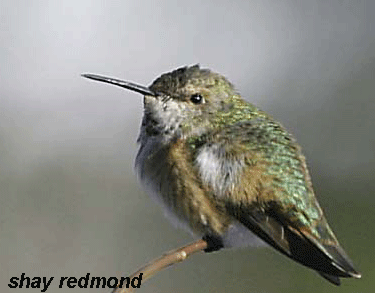An unidentified Selasphorus hummingbird spent fall 2005 and winter 2006 frequenting a hummingbird feeder in London, Ontario. As is often true with female or immature hummingbirds, despite close observation and photographs,  it was not possible to identify the exact species, in this case whether this was an Allen’s (S. sasin) or Rufous (S. rufus), species native to the western U.S. that normally winter in Mexico. Even in the hand, identification can be difficult and in banding studies most individuals are often simply recorded as “UNHU”, unidentified hummingbird species.
it was not possible to identify the exact species, in this case whether this was an Allen’s (S. sasin) or Rufous (S. rufus), species native to the western U.S. that normally winter in Mexico. Even in the hand, identification can be difficult and in banding studies most individuals are often simply recorded as “UNHU”, unidentified hummingbird species.
In this case, a single feather  spotted beneath the feeder was brought to University of Guelph, Ontario. DNA extracted from the feather and analyzed for COI barcode proved a match for S. rufus.
spotted beneath the feeder was brought to University of Guelph, Ontario. DNA extracted from the feather and analyzed for COI barcode proved a match for S. rufus.
Beyond solving a conundrum for birders, this case points toward a general utility of DNA barcoding in conservation assessments by enabling routine identification of otherwise unidentifiable species, including use of samples from live individuals which may be particularly important in study of threatened or endangered species.